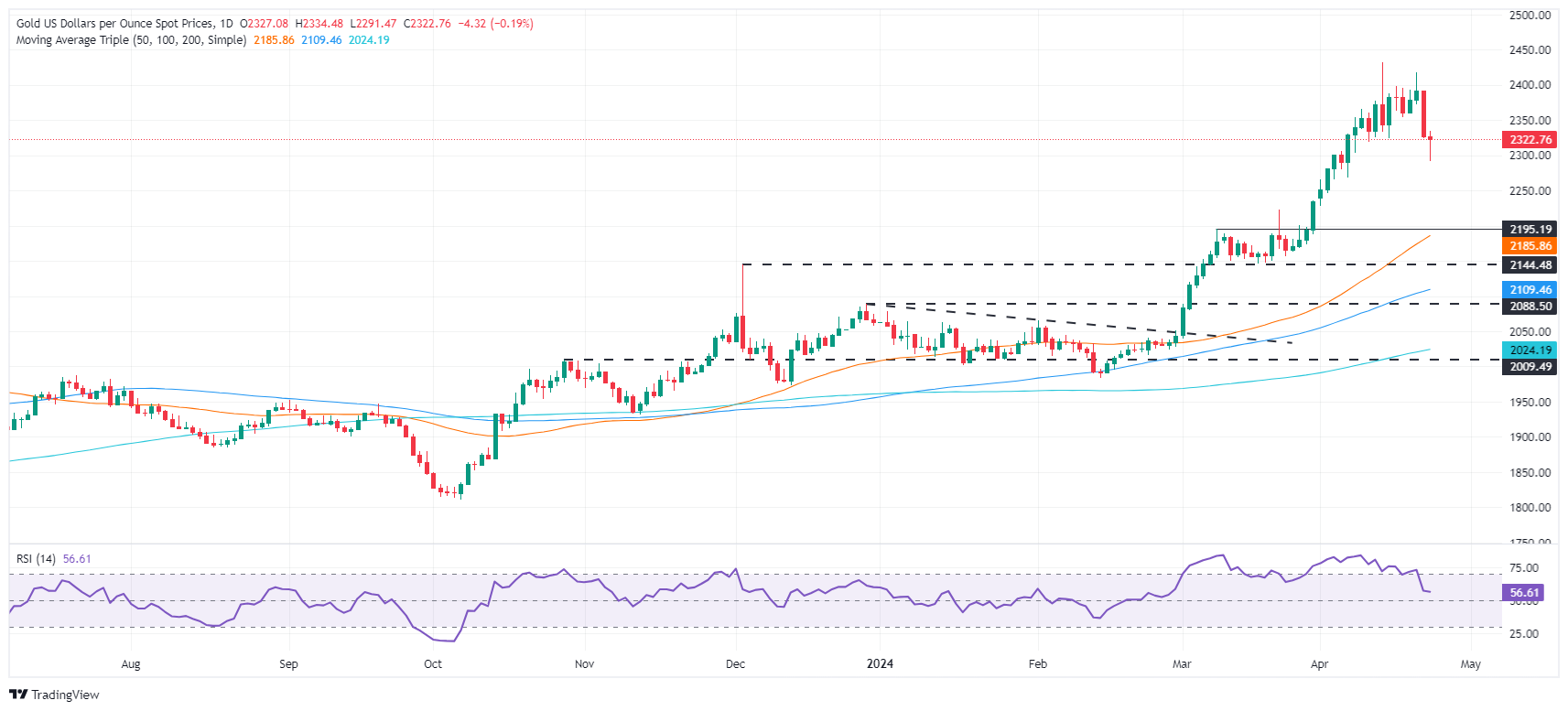Gold retreats modestly after failing to sustain gains despite fall in US Treasury yields, weaker US Dollar.
XAU/USD struggles to capitalize following release of weaker-than-expected S&P Global PMIs, fueling speculation about potential Fed rate cuts.
Geopolitical tensions ease somewhat, impacting Gold’s role as a safe-haven asset in times of turmoil.
Gold price posted modest losses late Tuesday in the North American session after reaching a high of $2,334, sponsored by a weaker-than-expected S&P Global Purchasing Managers Index (PMI) report. Buyers haven’t been able to capitalize on the Greenback weakness, while US Treasury yields dropped from the short end to the belly of the yield curve.
XAU/USD trades at $2,323, down 0.11%. The US 10-year Treasury yield stays firm at 4.402%, while the US real yields, which correlate inversely to Gold prices, drop 0.41% to 2.192%, a tailwind for the golden metal.
Geopolitical risks, despite lingering in traders’ minds, calmed following Iran’s attack on Israel and the latter’s retaliation. Data from S&P Global reignited rate cut hopes among investors following last week’s hawkish rhetoric implemented by Federal Reserve (Fed) officials led by Chairman Jerome Powell. One of the most dovish members of the FOMC, Chicago Fed Austan Goolsbee, echoed his comments, adding that progress on inflation has “stalled.”
Daily digest market movers: Gold remains steady, though tilted to downside following Monday’s slump
S&P Global revealed that US business activity in the manufacturing sector shrank. This month, the Manufacturing PMI dived from 51.9 to 49.9. On the other hand, the Services and Composite Index decelerated from 51.7 and 52.1 to 50.9 in both readings.
Other data showed that New Home Sales jumped to a six-month high, according to the US Department of Commerce, while Building Permits remained in contractionary territory despite being revised up from -4.3% to -3.7%.
US Dollar Index (DXY), which tracks the buck’s performance against a basket of six other currencies, plunges 0.44% to 105.68.
This week, the economic docket in the United States (US) will feature the release of the Gross Domestic Product (GDP) for the first quarter of 2024. Analysts estimate that GDP grew 2.5%, down from Q4 2023’s 3.4%.
Also, the US Bureau of Economic Analysis would reveal the preferred inflation gauge of the Fed, the March Personal Consumption Expenditure (PCE) Price Index. A softer reading than expected could prompt Gold traders to buy the yellow metal and aim to refresh all-time highs. Otherwise, a rise in prices could underpin US Treasury yields and the Greenback, a headwind for the non-yielding metal.
The PCE is expected to edge higher, while the Core PCE is expected to decrease from 2.8% to 2.6% YoY.
Data from the Chicago Board of Trade (CBOT) suggests that traders expect the fed funds rate to finish 2024 at 4.955%, down from Monday’s 4.99%.
Technical analysis: Gold price is at risk of diving beneath $2,300

After diving on Monday and forming a “bearish engulfing” chart pattern, the Gold price hit a two-week low of $2,291. However, XAU/USD buyers push prices above the $2,300 figure, but they’re not out of the woods yet. For them to stay in charge, they must lift Gold above the $2,350 psychological level, which could pave the way to challenge $2,400.
If they surpass that level, up next would be last Friday’s high of $2,417, followed by the all-time high of $2,431.
On the other hand, if XAU/USD sellers achieve a daily close below the April 15 daily low of $2,324, that would pave the way to test $2,300. A breach of the latter will expose the March 21 high at $2,222.
Gold FAQs
Gold has played a key role in human’s history as it has been widely used as a store of value and medium of exchange. Currently, apart from its shine and usage for jewelry, the precious metal is widely seen as a safe-haven asset, meaning that it is considered a good investment during turbulent times. Gold is also widely seen as a hedge against inflation and against depreciating currencies as it doesn’t rely on any specific issuer or government.
Central banks are the biggest Gold holders. In their aim to support their currencies in turbulent times, central banks tend to diversify their reserves and buy Gold to improve the perceived strength of the economy and the currency. High Gold reserves can be a source of trust for a country’s solvency. Central banks added 1,136 tonnes of Gold worth around $70 billion to their reserves in 2022, according to data from the World Gold Council. This is the highest yearly purchase since records began. Central banks from emerging economies such as China, India and Turkey are quickly increasing their Gold reserves.
Gold has an inverse correlation with the US Dollar and US Treasuries, which are both major reserve and safe-haven assets. When the Dollar depreciates, Gold tends to rise, enabling investors and central banks to diversify their assets in turbulent times. Gold is also inversely correlated with risk assets. A rally in the stock market tends to weaken Gold price, while sell-offs in riskier markets tend to favor the precious metal.
The price can move due to a wide range of factors. Geopolitical instability or fears of a deep recession can quickly make Gold price escalate due to its safe-haven status. As a yield-less asset, Gold tends to rise with lower interest rates, while higher cost of money usually weighs down on the yellow metal. Still, most moves depend on how the US Dollar (USD) behaves as the asset is priced in dollars (XAU/USD). A strong Dollar tends to keep the price of Gold controlled, whereas a weaker Dollar is likely to push Gold prices up.
Information on these pages contains forward-looking statements that involve risks and uncertainties. Markets and instruments profiled on this page are for informational purposes only and should not in any way come across as a recommendation to buy or sell in these assets. You should do your own thorough research before making any investment decisions. FXStreet does not in any way guarantee that this information is free from mistakes, errors, or material misstatements. It also does not guarantee that this information is of a timely nature. Investing in Open Markets involves a great deal of risk, including the loss of all or a portion of your investment, as well as emotional distress. All risks, losses and costs associated with investing, including total loss of principal, are your responsibility. The views and opinions expressed in this article are those of the authors and do not necessarily reflect the official policy or position of FXStreet nor its advertisers. The author will not be held responsible for information that is found at the end of links posted on this page.
If not otherwise explicitly mentioned in the body of the article, at the time of writing, the author has no position in any stock mentioned in this article and no business relationship with any company mentioned. The author has not received compensation for writing this article, other than from FXStreet.
FXStreet and the author do not provide personalized recommendations. The author makes no representations as to the accuracy, completeness, or suitability of this information. FXStreet and the author will not be liable for any errors, omissions or any losses, injuries or damages arising from this information and its display or use. Errors and omissions excepted.
The author and FXStreet are not registered investment advisors and nothing in this article is intended to be investment advice.
>>> Read full article>>>
Copyright for syndicated content belongs to the linked Source : FXStreet – https://www.fxstreet.com/news/gold-price-dips-slightly-amid-soft-us-dollar-lower-us-yields-202404232020















![[News] Japan Develops 10nm Nanoimprint Technology, with Potential to Tackle EUV Bottleneck – TrendForce](https://earth-news.info/wp-content/uploads/2025/12/329851-news-japan-develops-10nm-nanoimprint-technology-with-potential-to-tackle-euv-bottleneck-trendforce-360x180.jpg)















